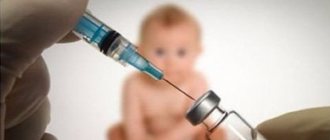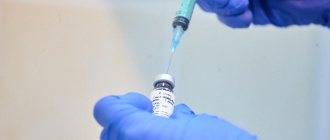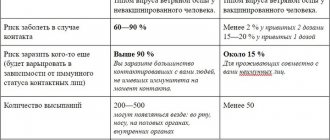Photo: medaboutme.ru
Victoria Mamaeva
Chief editor of Filzor. Specialist in the field of Pharmacy
Tatiana Senkina
Candidate of Medical Sciences, pulmonologist, phthisiatrician
Tuberculosis is one of the most terrible diseases of our world. Recently, in progressive countries, this problem has faded into the background in comparison with the epidemiological situation at the beginning of the last century, however, it has not been completely resolved.
You can protect yourself from the disease by vaccination with BCG . Short for Bacillus Calmette-Guérin , French - Bacillus Calmette-Guérin, BCG
.
Composition of the BCG vaccine
The vaccine contains live mycobacteria of the BCG-1 strain, which, when entering the human body, lead to the formation of long-term immunity to tuberculosis .
The decoding of BCG is a tracing of the Latin abbreviation (BCG), it stands for bacillus Calmette-Guerin, which means “bacillus Calmette-Guerin”.
The BCG vaccine can accommodate a variety of Mycobacteria bovis subtypes. The composition of this vaccine has remained the same since 1921.
The culture of mycobacteria that are used to make the vaccine is obtained by inoculating bacilli on a special nutrient medium. For one week, this culture grows on the medium, then it is isolated and filtered. After this, it is concentrated and made into a mass of homogeneous consistency.
As a result, the vaccine contains a certain amount of both dead and live bacteria. In this case, a single dose of the vaccine can contain a different number of bacterial cells, this depends on the subtype of mycobacteria, as well as on what technique was used in the manufacturing process of the vaccine preparation.
Release form
The BCG vaccine is produced in the form of a lyophilisate , which is subsequently used to prepare a suspension that is administered intradermally.
Available in the form of a porous powdery hygroscopic mass, also produced in the form of white or cream-colored tablets.
The vaccination dose contains 0.05 mg of bacteria in 0.1 ml of solvent (sodium chloride 0.9%).
5 ampoules of vaccine complete with solvent (also 5 ampoules) are packed in a cardboard box.
Explanation of BCG vaccination
The BCG vaccine was obtained by Guerin and Calmette on the basis of bovine mycobacteria. Scientists subcultured this strain 230 times in an environment uncomfortable for bacteria, using bile and glycerol. Work on this began back in 1908.
It turned out that after 4 years the virulence for livestock disappeared. After 13 years from the beginning of the experiment, the elimination of virulence for monkeys and rabbits was revealed. The individuals who participated in the experiment received protection from mycobacteria - they were not afraid of infection in the future.
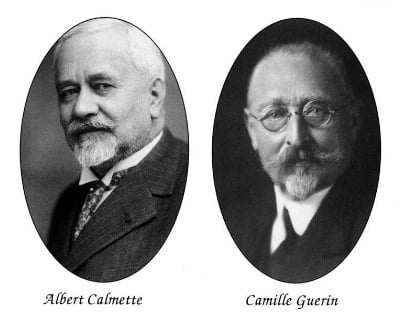
Albert Calmette (French: Leon Charles Albert Calmette) and Jean-Marie Camille Guerin (French: Jean-Marie Camille Guerin). Photo: estudiossocialesonline.com
Based on the results of many years of work, scientists created a strain named after them - BCG. In 1921, a child was vaccinated for the first time in France. The drug was administered orally.
Today, BCG vaccination and revaccination is included in the list of mandatory in 31 countries, and is recommended to the population in another 150. It is estimated that there are about 2 billion vaccinated people on the planet.
In the USSR, the medicine began to be used in 1926. In 1941, domestic scientists invented a dry vaccine. It could be stored for more than a year, while the liquid one used earlier retained its quality for only 2 weeks. This development has replaced the old form and is used by doctors to this day.
The BCG-M vaccine has also been developed , containing a smaller number of bacteria in 0.1 ml of the drug (compared to the first). Observations have shown that it is sufficient to create long-lasting immunity. BCG-M (decoding sounds like Bacillus Calmette-Guérin weakened) is used both for the first vaccination and for repeated preventive measures. Both in our country and in a number of CIS countries, BCG-M is the first choice vaccine for primary immunization. The incidence of side effects for such a drug is on average 5 times less in comparison with that inherent in BCG.
However, scientists do not stop improving the drug. Now the task is to completely abandon the use of living cultures. It is likely that in the future BCG will be replaced by a more effective and safe product created by genetic engineering methods, but for now the best protection against tuberculosis is the BCG vaccine.
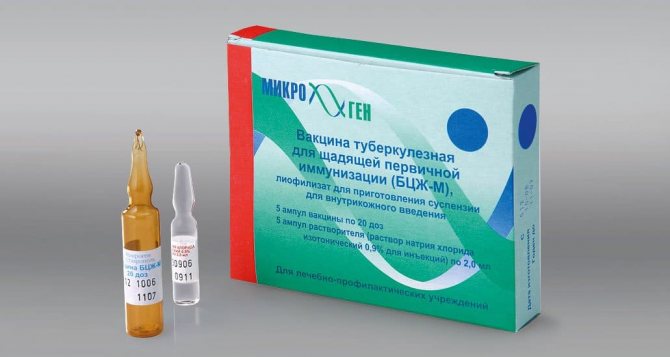
Tuberculosis vaccine (BCG-M). Photo: old.medach.pro
This is interesting: about the name! BCG is a reading of the foreign name BCG - an abbreviation for Bacillus Calmette-Guérin.
pharmachologic effect
Tuberculosis is one of the most dangerous infections, and it can develop in a child from the first days of his life. Its effectiveness depends on when the BCG vaccination is given. The earlier vaccination is carried out (as a rule, it is done on the third to seventh day), the more pronounced its effectiveness will be under the condition of contact with infection.
During the process of reproduction of live mycobacteria of the BCG-1 strain in the body of a person who has been vaccinated, long-term immunity to tuberculosis is gradually formed. The formation of full immunity against tuberculosis occurs over the course of about one year.
The response to BCG vaccination in newborns determines whether immunity has developed. Vaccination has been carried out successfully if a scar appears on the shoulder, and in the place where the BCG vaccine was administered, the consequences of locally suffered skin tuberculosis are visible. Accordingly, if the scar is very small and invisible, then insufficient immunization is noted.
When weighing the pros and cons of vaccination, it should be noted that the use of the vaccine does not help reduce the spread of tuberculosis. However, vaccination provides protection against severe forms of the disease, which are especially dangerous for children's health.
Principles and purposes of vaccination
The BCG vaccine, although capable of preventing up to 80% of severe forms of infection in children, is not a means of controlling tuberculosis infection, since it does not prevent primary infection or reactivation of latent tuberculosis, which becomes the main source of spread of mycobacteria among the population. If left untreated, both conditions are usually fatal. It is generally accepted that the vaccine provides the greatest protection against severe forms of tuberculosis - disseminated and with brain damage. Thus, over the past years, BCG vaccination has saved thousands of lives. This vaccine is relatively safe. Despite its shortcomings, BCG vaccination is considered life-saving and an important element of standard tuberculosis control measures in most endemic countries.
Contraindications for BCG
The following contraindications for BCG vaccination have been noted:
- birth of a child prematurely (provided that the birth weight is less than 2500 g);
- intrauterine infection;
- development of acute diseases (it is necessary to postpone the introduction of vaccination until the exacerbation is over);
- purulent-septic diseases;
- severe and moderate forms of hemolytic disease in newborns;
- primary immunodeficiency ;
- the presence of neurological symptoms in severe damage to the nervous system;
- generalized skin lesions;
- the presence of malignant tumors;
- simultaneous use of immunosuppressants;
- carrying out radiation therapy (vaccination can be practiced only 6 months after completion of treatment);
- the presence of generalized tuberculosis in other family members;
- Diagnosed HIV infection in the mother.
The same contraindications are noted for the administration of the BCG-M vaccine.
Revaccination is not carried out in the following cases:
- during acute diseases, both infectious and non-infectious;
- for acute manifestations of allergic diseases ;
- with immunodeficiency;
- in the event of the appearance of neoplasms and malignant blood diseases;
- when undergoing radiation therapy or taking immunosuppressants (booster vaccination can be carried out only six months after completion of such therapy);
- tuberculosis (also a history of illness or infection with mycobacteria);
- with a positive or questionable Mantoux reaction;
- in case of contact with patients who have infectious diseases;
- when complicated reactions to the vaccine administration occur (in particular, if complications of BCG vaccination were noted in the form of lymphadenitis , keloid scar).
Deviations from the norm
If the child’s body does not show any reaction to the vaccine, this may indicate two things: lack of immunity or improper vaccination. Usually such a child is given a Mantoux test. Repeated vaccination is carried out if the test result is negative. Another way to solve the problem is to re-introduce the drug at seven years of age.
Sometimes a lack of response to a vaccine is a sign that the child has innate immunity. In this case, a scar does not form. How to understand that a child has innate immunity? If this is so, after performing the Mantoux test, only the vaccination mark will be visible on the hand; there will be no reaction to the test.
There are cases when a scar forms not on the surface of the skin, but under it. Only a doctor can determine its presence, because it differs only in slight redness. This reaction indicates deep skin changes. You can tell that the vaccine is no longer effective when the scar disappears.
Complications may also occur during the course of the vaccine. They can be identified by the appearance of the grafting site:
- cold abscess (with subcutaneous administration of the drug instead of intradermal);
- the appearance of a large diameter ulcer;
- inflammatory processes in the lymph nodes;
- osteitis or bone tuberculosis (can develop 6 months or even several years after vaccination);
- BCG infection with inflammation around the injection site and beyond;
- keloid scar.
Keloid scars are similar in appearance to burn scars. They are capable of growing.
As the scar grows, signs are observed:
- redness or brownish tint;
- capillary network inside the scar;
- abnormal shape.
The scar looks like a tumor. The reasons are given below:
- long-term non-healing of inflammation;
- violations of the genetic consistency of the skin;
- incorrect administration of the vaccine.
Only intensive therapy helps stop or partially slow down the process of scar formation. After repeated vaccination, it will no longer be possible to remove the scar.
Hypertrophy and keloid scars
Keloid scars rise above the surface of the skin; growing scars are unable to shrink and resolve. Children may experience pain when touched and itching. The appearance of a scar can also be affected by the quality of the vaccine administered. Often, keloid appears only after repeated vaccination. In this case, healing the scar is almost impossible, and intensive therapy can only lead to scar growth.
Hypertrophic scars differ from keloid scars; they do not have capillary networks and are not swollen. Their surface is rough and does not have a bright color. Hypertrophic nodes do not cause itching and disappear after some time.
Side effects
The occurrence of side effects is determined by the ingredients of the BCG vaccine, what it is, and how it acts on the body. It should be noted that the drug contains live BCG mycobacteria, therefore, a reaction to BCG vaccination invariably occurs. What such manifestations may look like is clearly demonstrated by photographs of the reaction to the BCG vaccination.
During the normal course of the process, a specific reaction appears at the site into which the vaccine is injected intradermally; a papule with a diameter of 5-10 mm develops. If vaccination was carried out on newborns, a normal reaction will appear after 4-6 weeks. Reverse development of the reaction occurs within 2-3 months, sometimes it is a longer process. During revaccination, the development of a local reaction is observed 1-2 weeks after administration of the drug.
Complications after vaccination may occur at different times after administration of the drug. Symptoms of the consequences of BCG complications are most often observed in the first six months after administration of the vaccine.
In general, complications in newborns and older children can be severe or mild. Severe complications after vaccination in newborns are associated with generalization of the infection. Lungs occur due to non-compliance with the technique of administering the drug or its poor quality.
Most often, after vaccination and revaccination, the manifestation of cold abscesses , as well as lymphadenitis, . The manifestation of lymphadenitis is often associated with the quality of the drug, dosage, and administration technique.
The development of cold abscesses is noted if the vaccine gets under the skin during administration. The quality of the drug also influences the development of such negative manifestations. If a cold abscess was discovered untimely, then it opens spontaneously after the graft has festered. As a result, an ulcer appears at this place. A photo of a cold abscess after BCG clearly demonstrates the features of this complication.
If local reactions after vaccination occur very violently, an infiltrate . Subcutaneous infiltration occurs due to too deep administration of the vaccine. It is important to consult a specialist in a timely manner so that the infection does not have time to move into the bloodstream.
It is also possible that a keloid scar as a consequence of chronic inflammation in the proliferation stage. This complication occurs relatively rarely, but it should be taken into account that this complication more often occurs in newborns.
osteitis , that is, bone tuberculosis, appears as a complication This disease can appear 0.5 - 2 years after immunization; it, as a rule, indicates serious disturbances in the functions of the child’s immune system.
In rare cases, a child may experience a slight increase in body temperature after an injection, most often this is a small, short-term increase.
If these and other side effects develop, it is important to immediately contact a specialist.
Risk of post-vaccination complications
Generalized BCG infection is a consequence of severe congenital disorders in the immune system of the vaccinated person, as a result of which the body cannot cope with BCG, and the process goes from local to widespread. It should be said that severe congenital immunodeficiencies in themselves are life-threatening, so BCG, in fact, only reveals this disorder, but is not its cause. It makes no sense to blame the BCG vaccine for unwittingly “helping” to identify this disorder - any other more common infection (E. coli, pneumococcus) could have taken the place of BCG, which would lead to exactly the same consequences. Generalized BCG infection occurs in less than 1 case out of 300,000 vaccinations, with mortality without treatment in 1/2,000,000 vaccinated people.
BCG infection distant from the vaccination site (osteitis) is registered after 7-24 months. after vaccination. This complication is also a consequence of gross disturbances in the immune system, when the body is unable to cope with the bacteria in BCG. Frequency: less than 1 in 100,000 vaccinated people.
Instructions for use (Method and dosage)
The instructions for the vaccine stipulate that the drug is administered to a person three times in his life. The first vaccination is carried out 3-7 days after the child is born, followed by BCG vaccination at 7 years of age. After this, the vaccine is given at 14 years of age.
In this case, the connection between BCG and Mantoux should be taken into account: revaccination at 7 years of age and at 14 years of age is carried out only if the Mantoux test is negative. Also, revaccination is not carried out in areas where there is a relatively low prevalence of the disease.
If a child has contraindications, the vaccine can be administered to him if his condition returns to normal. Before administering the drug, the child must undergo the Mantoux test. If the test is negative, vaccination should be carried out as soon as possible. If the test is positive, the vaccine is not administered.
Do not use syringes whose expiration date has expired. After the injection, the syringe, needle and used cotton swabs should be soaked in a disinfectant solution, after which all this should be destroyed. Before use, the ampoules must be carefully inspected and determined whether they have been damaged or whether the expiration date has expired.
The vaccine, which has already been dissolved, must be protected from exposure to sunlight; it can be stored after dilution for one hour. Unused vaccine is destroyed at a temperature of 126 degrees by autoclaving.
The drug should be injected into the outer side of the left shoulder. The location is determined so that the vaccine is administered at the border between the upper and middle third of the arm. It is very important to administer the medicine intradermally; other methods of administration are unacceptable. Provided that for certain reasons it is not possible to administer the vaccine into the shoulder, you can choose another place with thick skin. Most often in this case it is injected into the thigh.
BCG should only be administered using a disposable syringe, and the needle should have a short bevel. To prevent complications, you need to administer the drug correctly. Before inserting it, the skin needs to be stretched, and then a little solution is injected. If the needle was inserted intradermally, then the entire solution is injected. Next, a white papule appears at the injection site, which is 5 to 10 mm in diameter. It disappears after 15-20 minutes.
As a rule, BCG and BCG-M vaccines are administered in the maternity hospital or in the clinic where the child is observed. After vaccination, you should carefully care for the area where the drug was administered. Under no circumstances should you lubricate this area of skin with antiseptics.
Please note that there are normal reactions after a child is given a vaccine. So, if the vaccine in a newborn turns red, this indicates the normal course of the process.
After a newborn has been vaccinated, a normal reaction in an infant appears after 1-1.5 months. After repeated administration of the vaccine to children aged 7 and 14 years, the reaction develops earlier, after 1 or 2 weeks. After the reaction develops, you should not rub or scratch the area; you should wash the child very carefully.
The vaccination reaction is as follows: a pustule or papule is formed, and slight suppuration is noted in the place where the vaccine was administered. Gradually, after 2-3 months, the wound heals. A small scar should remain at the site of this wound. If there is none, it means the vaccine was administered incorrectly. The wound can take up to 4 months to heal.
Where is the vaccine given?
The drug is administered intradermally. A single dose of BCG for children is 0.05 mg. To dissolve the powder, use 0.1 ml of sodium chloride.
Primary vaccination is usually indicated on the day of discharge from the hospital. If deviations are identified, vaccination is prescribed immediately after recovery. Usually, BCG is not used after the maternity hospital, giving preference to BCG-M. If the child is two months old or older, a Mantoux test must first be done. The personal card indicates the date of the event, the name of the vaccine, the manufacturer, its expiration date and the batch number. By the way, the opinion that you can’t bathe after BCG is just a common myth. The water is safe, but rubbing and scratching the area is really prohibited.
- The vaccine is sealed under vacuum conditions, so you must first cut the ampoule and only then break off the head. One ampoule contains 10 doses.
- Transfer 1 ml of liquid into the ampoule with a syringe and wait for dissolution for one minute. The finished product is a coarse suspension; color - white, grayish or slightly yellowish. It must be used immediately. Protect from light with a black paper cylinder. For diluted BCG vaccine, the shelf life is an hour.
- 2 doses of the vaccine are drawn into the syringe, half of the product is released with a needle, displacing the air. Having filled the syringe, they immediately give an injection.
- The BCG vaccine is administered intradermally. Zone - left shoulder, outer part, border of the first and second thirds.
- Pre-disinfect the area with alcohol.
- The bevel of the needle is inserted into the stretched skin. First, a very small amount of medicine is injected to check the correct position of the needle, then the rest of the volume is injected.
- If a white papule appears after injection, it means the injection was done correctly. After BCG injection, the size of the papule is up to 9 mm. The trail lasts for about half an hour. This reaction to BCG in a child is an absolute norm.
The risk of an abscess after BCG, when administered correctly, is minimal.

Where is BCG vaccination given to newborns? Photo: slide-share.ru
special instructions
When deciding whether or not to vaccinate their child with BCG, parents should carefully read the recommendations given by experienced pediatricians (for example, Evgeny Komarovsky and others).
All arguments should be taken into account, clearly understanding what the BCG vaccination is for and what the risk will be if parents deliberately refuse to have it.
After vaccination, a child’s immunity can last for about 5 years. To maintain immunity, revaccination is carried out.
The Mantoux test is performed on a vaccinated child according to a schedule and allows you to determine what the child’s anti-tuberculosis immunity is at the moment.
Vaccination and revaccination should be carried out only by specially trained physicians working in specialized medical institutions. It is prohibited to administer the vaccine at home.
Before vaccination in the clinic, the child must first be examined by a specialist.
Price, where to buy
The BCG vaccine is stored in medical institutions where vaccination is carried out. The price in pharmacies should be checked.
- Online pharmacies in RussiaRussia
- Online pharmacies in UkraineUkraine
LuxPharma* special offer
- OncoTice BCG 1 bottle
RUB 7,800 order
show more
